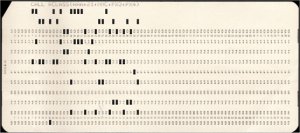Just What is the Excitement of 8 bit Computers?
This will be a history lesson of a sort (hopefully an interesting one). You will be reading this on your computer. You may have more than one in the house (there are loads in mine), they may even all be connected to a network. So, why the big deal? Now lets trip back to 1975 when I started my degree course. I had once seen a computer, it filled an enormous room and was used by a handful of woman who entered data into it. There was a man involved somewhere but I could not work out what he did. In those days, computers were designed and built by men and used predominantly by women as data entry clerks. In my second year, I discovered not only that my University HAD a computer (a DEC PDP-11 - you will not find it mentioned again in this book - definitely NOT a home computer) but that we were actually going to program on it. I could barely sleep for excitement!! I will discuss BASIC programming a little later but this was quite different. The language was something called Fortran 4 and we coded it on punched cards. Here is one:

A punched card represented a line of my program. Here is a little bit of Fortran code; don't worry about how it works:
program mytestinteger year, month, days
year=1904
month=2
days=5
call calend(year,month,days)
write(*, 20) days
20 format(i5)
End
One line above equals one card. The cards were all then collected together in a stack. On one occasion, I dropped the pile and spent hours putting them all back in order again - Oh how I laughed! Shuffled cards aside, you then submitted your "pack" to the data centre operator and went for a well-earned drink. The next morning you would return to pick up your pack with a red line through card 3 indicating an error on that card. Perhaps you had written month==2 by accident. You punched a new card, put that in the pack and tried again the next night. Invariably, the next day returned another red line through 4 then 5 then 6 and so on. Then, one fine day, your deck was returned unmarked and along with it the output you had requested. You gently held this beautiful piece of cheap and nasty paper just to find the results were nothing like you had expected, your code was wrong: go back to start.
I was working on a relatively simple statistics package (to do means, standard deviations etc) and was probably nowhere near getting it finished when, one day, the centre sprouted teleprinters. These were huge, noisy and difficult to type on. We had to program in BASIC (nearly there, patience) but the computer actually talked to you. Enter the line
20 LET x=x+_-5
And the computer just bounced back:
Syntax error in line 20.
You changed the line
20 LET x=x+5
And on to the next line.
Within a single afternoon, I had entered my program, fixed the bugs and had the whole thing running. It is safe to say that I was hooked.
So then I went and bought my own computer - not. This was five years before Clive Sinclair produced his ZX80. The first "home" computer had been produced in the States, the Altair 8800. It was $595 or, with shipping, about the same as my total bills for a term. This was also the kit price, you had to solder it all up and test yourself. This needed the sort of buying power that you need to obtain a Ferrari just because you like the colour!
For years, my computer fix was obtained on what were then called mainframes. The favourite computer game of the day was called Adventure, the line:
YOU ARE STANDING AT THE END OF A ROAD BEFORE A SMALL BRICK BUILDING. (computers did not do lower case)
was enough to get any computer geek excited. The game, by the way, was frustrating and relied entirely on imagination and inputing EXACTLY what the computer wanted to here (TRAP THE BIRD WITH THE CAGE). It was fantastic.
In the States, computers were moving on. In 1977, the Apple 2, Commodore Pet and TRS-80 were all released, they arrived fully built, worked and the price was coming down a little. In 1978, a little company called Sinclair Radionics, who had previously built minute radios and cheap stereo amplifiers, brought out the MK-14. This cost an almost affordable £40 (a few days wages for many people) and 20,000 people bought one. It had to be programmed in hexadecimal in machine code (both enough to frighten away all but the biggest nerds) and you could not save your program so it had to be typed in every time. That said, with 128 BYTES of memory that did not take very long! In the US, the Superboard II came with a proper keyboard, BASIC, a massive 4,000 BYTES of memory and you could save your program to a cassette tape. They did cost around £120 imported or around a week's wages. Then, finally, in 1978, the first "proper" British computer, the Nascom 1, based on the SuperBoard 2 but a massive £199 in kit form for a circuit board with a keyboard built on the end. 1979 saw two more "affordable" computers released, the Compukit UK101 (£249) and the MicroTan 65 (around £100). All of these were released in kit form for the user to assemble and test themselves.
For most people, the computer did not really arrive until 1982 with the arrival of the Sinclair Spectrum, Commodore 64 and BBC Model B. Then things exploded!!!
